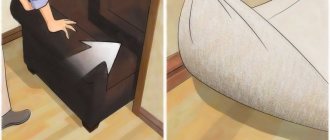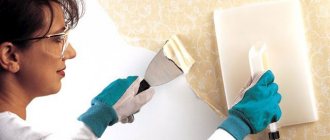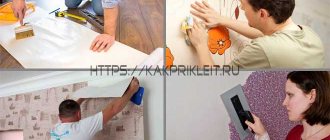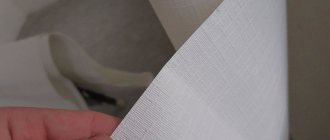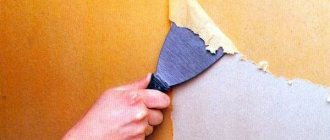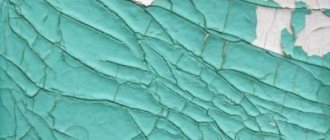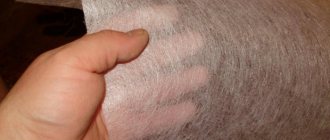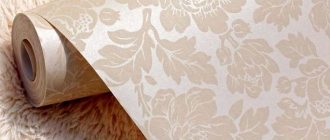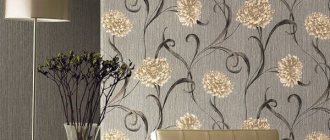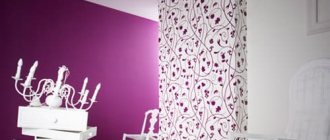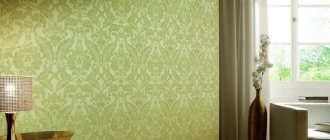Today in the article we will talk about dismantling old non-woven wallpaper. If your walls are covered with non-woven wallpaper and you have questions about removing them, then this article is just for you. It’s worth immediately telling you that it makes no difference what kind of wallpaper you dismantle, liquid, washable or non-woven, because the basis of everything is paper, and everything else is just the top protective layer. In the case of non-woven wallpaper, the top layer may be impregnated, preventing water from penetrating into the structure of the wallpaper. However, this does not mean that this wallpaper cannot be very wet. Still, the easiest way to remove wallpaper without resorting to any tools is to use warm water. Yes, if you have a steamer, an industrial hair dryer, or a heat gun lying around on the mezzanine, then they will be useful for removing non-woven wallpaper. For all those who do not have these devices, you will have to soak the non-woven wallpaper as much as possible.
Non-woven wallpaper itself is a pretty good material that adheres reliably to the surface of the walls, especially if the walls have been primed. In order to remove such wallpaper from the walls, you need to use different means, but the main thing you need is time and nerves.
How to remove non-woven wallpaper using a spatula
- The most proven way to remove non-woven wallpaper is an ordinary spatula.
- To remove, you will need to fill the spray bottle with warm water and any detergent.
- Next, you simply spray water on the walls, evenly saturating them with moisture.
- You need to wait a little until the wallpaper softens. You'll need a lot of water!
- Then move on to the spatula and start removing the wallpaper.
- Despite all the primitivism of this procedure, this is the most effective way to remove any wallpaper, including non-woven wallpaper.
Preparatory stage
Before you begin removing vinyl wall coverings, you need to prepare the room. It is best to clear the room of furniture. During the work, it can get dirty and simply get in the way. Interior elements that cannot be removed are covered with film or sheets. It is also better to cover the floors with film. Place sheets of cardboard or fairly thick paper on top of it. A damp cloth is laid on the threshold. It will collect dust and debris.
To avoid electrical accidents, experts recommend turning off the power to the wiring. To reduce the risk of moisture getting into sockets, it is recommended to cover them with film.
3
Vinyl - remove from the wall in three ways
Compared to conventional paper decorative covering, vinyl wallpaper is not so easy to remove. In order for the process to be effective, three methods can be used. The first consists of stages:
1. Perforation. In order to separate the paper from the wall, just wet it. It won't be that easy with vinyl, because... it does not allow water to pass through. It is necessary to make sure that holes are formed in the outer layer through which moisture gets onto the paper backing. To do this, treat the top layer with a special spiked roller. This will help not damage the wall and allow water to enter the material.2. Hydration. Treat the surface with a damp cloth or roller. To do this, you can use either ordinary warm water or a special removing liquid.3. After the material is well saturated with moisture, remove it, starting from the bottom up. Remove the remaining pieces with a spatula; it is better if it is wooden - this way you will avoid the appearance of damaged areas.
We recommend: DIY interior decorative pillows for the sofa
To moisten the wallpaper, you can use a damp cloth and regular warm water.
The older the coating, the longer it will take to saturate it. Very old vinyl wallpaper should be kept damp for about an hour - after that it will not be difficult to remove it from the walls. Usually the material comes off in whole stripes, without breaks.
The second method is suitable for cases where strong glue was used or the coating is very ancient. Instead of a spatula, take any of the following tools:
a drill and a special attachment in the form of a round brush; coarse sandpaper and a grinder; a regular metal brush for washing dishes.
The first two options will help you get rid of old coating quickly and with a minimum of effort. The third one will have to work hard. All three methods are suitable when there is no plaster on the wall under the wallpaper layer. If available, use the latter method. First, treat the wall with a needle roller, wet the surface with water mixed with fabric softener, vinegar and ammonia in approximately equal proportions. Wait 20 minutes - the old glue dissolves, the wallpaper sheets can be easily peeled off without damaging the wall base.
How else can you remove non-woven wallpaper?
Instead of soaking the wallpaper, you can try warming it up, for example with a hair dryer or a heat gun, if, of course, you have such tools. By heating the wallpaper, you soften it and the glue, making it easier to dismantle.
Alas, these are all the main methods that are suitable for removing non-woven wallpaper from walls. If in your case this was not possible, then your wallpaper fits perfectly on the walls and you will have to tinker with it a little longer than you planned.
The third way to remove wallpaper
You can remove them layer by layer. Use a needle roller to process the wall, that is, make the same perforation. After this, moisten the second layer with water, to which you can add the following composition: fabric softener + vinegar + ammonia. After just twenty minutes the coating can be removed.
This principle repeats the first one, only the composition of the aqueous solution changes, which helps dissolve the adhesive layer.
By the way, if you remove the coating with a spatula, make sure that there is no layer of plaster underneath it. The spatula will deform it, and you will have extra work.
Conclusions on the topic
Thus, we became acquainted with the topic of dismantling non-woven wallpaper. If you have questions, you can ask them in the comments to this article, and we or our users will help you with the answer. It is also worth understanding that different manufacturers add different chemicals to wallpaper, which in one way or another affect the density of this wallpaper and its ability to transmit water or steam. For all the wallpaper in the world, there is no one really effective way to remove it, because what works with some wallpaper may not work with others. Keep this in mind!
Good luck with your renovation!
Tools and materials
The choice of tool depends on the type of old finish that needs to be removed. Here is the most complete set of tools and devices that will help you quickly peel off obsolete wallpaper that has lost its former attractiveness:
knives, spatulas, scrapers; “wallpaper tiger” or roller with nails; steam generator; wide roller with extension handle (for ceiling); hard brush; spray;
special liquid for removing wallpaper; drill or grinder with a brush attachment; old blankets, film or packaging cardboard to protect furniture and floors; gloves and headgear; scotch; old rags or sponge; container with warm water.
You are unlikely to need a full arsenal, but it won’t hurt to stock up on most auxiliary equipment.
Before removing old wallpaper, do not forget to remove everything unnecessary from the room, remove curtains, take out carpets, and seal sockets and switches with tape to prevent moisture from entering them.
USEFUL INFORMATION: How to prepare walls for painting with water-based paint with your own hands
Methods for removing old paintings
Removing regular paper-based wallpaper is easy. To do this, you just need to moisten their surface with warm water, wait a while until the liquid thoroughly saturates the canvas, and then use a spatula to remove the material from the wall. But unlike ordinary paper-based wallpaper, vinyl sheets have the quality of being resistant to water. In this case, it is necessary to use more effective control methods.
Related article: DIY patterns for curtains and lambrequins
Water use
In order to quickly tear off wallpaper from the wall surface, it is necessary to use rollers with spikes. If there is no such device, then you can use a regular knife, but they will have to act carefully. Due to the multi-layer structure, such wallpapers keep the wall intact. Using the presented tools, only the first layer of canvas is damaged.
The wallpaper comes off the wall perfectly, sometimes the backing remains
When you have managed to render the first layer of material unusable, you can now take water, add dishwashing liquid to it and apply it to the surface of the wall. Thanks to the added component, the glue will begin to dissolve quickly, and old wallpaper will be easier to remove. To wet the surface, you can use a roller, foam sponge, or spray bottle. In this matter, it is important not to overdo it so that damage does not occur on the floor and wall.
When old wallpaper is saturated with water, you can carry out a procedure to remove it. The process of removing the canvas should occur from the bottom up. All remaining pieces of wallpaper are removed using a spatula. If it is not easy to remove wallpaper from the walls, then you need to apply water to its surface again, and then remove it again. When the vinyl wallpaper adheres very tightly and firmly to the wall, you can not remove it, but carry out further gluing directly on it.
Steam application
Our experts told us an interesting way to remove vinyl wallpaper using steam, which is used quite rarely, but is very effective.
Using a steam generator to remove wallpaper
You can quickly remove old paintings from walls using steam. To perform this operation, you need to stock up on a steam generator or an iron that has a steaming function. When performing such activities, the steam affects only the first layer of wallpaper, as a result of which they begin to lag behind the wall.
Using steam is not only a quick way to remove old coating, but also the cleanest method, because it leaves no traces of dirt behind. In addition, this option can be used when you need to peel off the interlining.
As an alternative, you can try a wet rag and an iron. The material is laid on the wallpaper, and then run over it with an iron. The resulting effect can be compared to that obtained from using a steam generator.
Article on the topic: Construction of a swimming pool on a summer cottage with your own hands, photo
Using wallpaper glue
You can remove old paintings from walls using a special composition that dissolves in liquid, as well as a small amount of glue. The resulting product is evenly distributed on the wallpaper, and then allowed to rest for 3 hours. The method used allows you to remove wallpaper not in pieces, but in sheets at once. Everything is simple, because when gluing the canvases, a different wallpaper glue was used.
Simple steps for dismantling wallpaper
You can also remove material using a wire brush, sandpaper and a sander. But all activities must be carried out carefully and carefully so as not to damage the wall.
Removing wallpaper from drywall
Very often people use plasterboard sheets to level walls. They are easy and quick to attach and do not leave behind dirt, as when using plaster. But what if vinyl chips need to be removed from just such a surface? It is important here not to damage the drywall, otherwise you will have to carry out measures to restore it, and this is a waste of time and money.
You should not use water to remove the sheets, because drywall does not tolerate moisture very well. The process of removing material must be carried out very carefully. First, apply a small amount of water, then you need to wait until the top coating of the wallpaper is wet and then take a spatula to carefully remove the old material. In this case, you can add special products to the liquid that are designed to remove vinyl coating specifically.
Plasterboard walls ready for wallpapering
If the gluing process was carried out using special glue for vinyl sheets, the dismantling process will not be difficult. Also, difficulties will not arise provided that putty and primer were applied to the sheets of drywall before applying the wallpaper.
It is very easy to remove non-woven fabrics, because it is possible to delaminate them. To do this, you need to pry off the top layer with a knife after wetting it with water and tear off the unnecessary material. If you used PVA compound to glue the wallpaper, then you will not be able to harm the coating. In this case, the integrity of the sheets is necessarily compromised.
Related article: Installing plastic doors with your own hands: instructions (photos and videos)
Preparatory work
The first thing you need to do is clean the room, this is done very easily: you need to take out all the furniture if possible or cover it with a film to remove dirt.
The floor can also be covered with polyethylene and covered with newspapers - this is necessary so as not to slip on the surface.
When leaving the room, you need to put a wet rag down so that the dust does not spread throughout the house.
To avoid accidents, it is better to turn off the electricity, and it is better to remove lighting fixtures located on the wall altogether.
As for sockets and switches, the wallpaper underneath them must also be removed.
To do this, the screws are unscrewed (not completely or completely), the wallpaper in this place is torn off, after which the switches are put in place. Thus, the room is prepared very quickly.
To also quickly remove wallpaper from walls, you will need the following tools:
- A roller with spikes, otherwise called a “wallpaper tiger”;
- A bucket of warm water. Dishwashing detergent added to water will make removal easier;
- Foam sponge, roller or spray;
- Putty knife;
- To ensure the integrity of the outlet, it is better to seal it with masking tape, which is removed after the work is completed;
- Gloves;
- Ladder.
Plasterboard walls
How to remove old vinyl wallpaper if the walls on which they were glued are made of plasterboard?
It should be noted that this material does not tolerate moisture well; even when using moisture-resistant drywall, excessive moisture can injure it.
You need to remove old wallpaper from a plasterboard wall very carefully: they are first perforated and also moistened with water, but there is no need to overdo it here.
It is better to use special tools for removing old vinyl covering. The general technology for removing plasterboard from a wall remains the same as when using water.
If the wallpaper was glued with a special (vinyl material) glue, then dismantling will be easy.
Also, problems with removal will not arise if the drywall has been puttyed beforehand.
Wallpaper with a non-woven backing will be easier to remove, because it can be peeled off (the top layer, which does not allow moisture to pass through, can be pryed off with a knife or spatula and peeled off); the base can be easily removed by soaking.
There may be cases when PVA glue was used for gluing. Here, no matter how careful you are, you will not be able to maintain the integrity of the drywall.
Watch the video to better understand how to remove wallpaper from drywall.
Video:
Vinyl wallpapers
As a rule, vinyl wallpaper consists of two layers.
In the manufacture of vinyl wallpaper, the main component is polyvinyl chloride (PVC). Currently, almost all coatings are created on the basis of this material. As a rule, such coatings consist of two layers. The backing is made of non-woven fabric or paper, and the decorative part is made of vinyl.
For mid-price material, the backing is made of paper, since the raw material itself is inexpensive, and the outer part of the coating is made of foamed vinyl. Non-woven fabric is used to make the base of wide and expensive rolls. A meter roll weighs much more than a standard one. To keep the canvas securely on the wall, use a non-woven backing.
Vinyl canvases have a wide variety of colors and textures
The advantages include the following qualities:
- average price per roll;
- variety of colors and relief;
- environmentally friendly, harmless to the environment and humans;
- coating strength;
- resistance to detergents;
- resistance to high temperatures;
- durability.
There are four types of vinyl sheets:
- Foamed. The base is made of paper, the top layer of coating is made of foamed vinyl.
- Relief and dense. Imitate natural finishing materials.
- Hot stamping. Hot presses are used to produce such material.
- Silkscreen printing. The bottom layer is made on a paper basis, and the front part imitates silk.
Depending on what type is chosen for pasting the room, an individual scheme will be selected for removing them from the surface.
